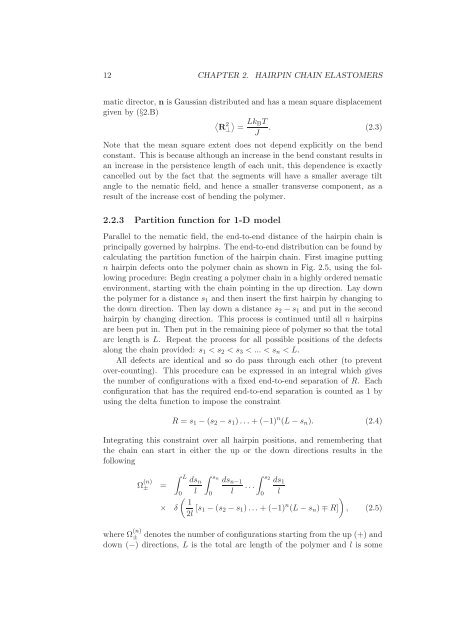Statistical models of elasticity in main chain and smectic liquid ...
Statistical models of elasticity in main chain and smectic liquid ...
Statistical models of elasticity in main chain and smectic liquid ...
You also want an ePaper? Increase the reach of your titles
YUMPU automatically turns print PDFs into web optimized ePapers that Google loves.
12 CHAPTER 2. HAIRPIN CHAIN ELASTOMERSmatic director, n is Gaussian distributed <strong>and</strong> has a mean square displacementgiven by (§2.B)〈 〉R2 Lk B T⊥ = . (2.3)JNote that the mean square extent does not depend explicitly on the bendconstant. This is because although an <strong>in</strong>crease <strong>in</strong> the bend constant results <strong>in</strong>an <strong>in</strong>crease <strong>in</strong> the persistence length <strong>of</strong> each unit, this dependence is exactlycancelled out by the fact that the segments will have a smaller average tiltangle to the nematic field, <strong>and</strong> hence a smaller transverse component, as aresult <strong>of</strong> the <strong>in</strong>crease cost <strong>of</strong> bend<strong>in</strong>g the polymer.2.2.3 Partition function for 1-D modelParallel to the nematic field, the end-to-end distance <strong>of</strong> the hairp<strong>in</strong> cha<strong>in</strong> ispr<strong>in</strong>cipally governed by hairp<strong>in</strong>s. Theend-to-end distribution can befound bycalculat<strong>in</strong>g the partition function <strong>of</strong> the hairp<strong>in</strong> cha<strong>in</strong>. First imag<strong>in</strong>e putt<strong>in</strong>gn hairp<strong>in</strong> defects onto the polymer cha<strong>in</strong> as shown <strong>in</strong> Fig. 2.5, us<strong>in</strong>g the follow<strong>in</strong>gprocedure: Beg<strong>in</strong> creat<strong>in</strong>g a polymer cha<strong>in</strong> <strong>in</strong> a highly ordered nematicenvironment, start<strong>in</strong>g with the cha<strong>in</strong> po<strong>in</strong>t<strong>in</strong>g <strong>in</strong> the up direction. Lay downthe polymer for a distance s 1 <strong>and</strong> then <strong>in</strong>sert the first hairp<strong>in</strong> by chang<strong>in</strong>g tothe down direction. Then lay down a distance s 2 −s 1 <strong>and</strong> put <strong>in</strong> the secondhairp<strong>in</strong> by chang<strong>in</strong>g direction. This process is cont<strong>in</strong>ued until all n hairp<strong>in</strong>sare been put <strong>in</strong>. Then put <strong>in</strong> the rema<strong>in</strong><strong>in</strong>g piece <strong>of</strong> polymer so that the totalarc length is L. Repeat the process for all possible positions <strong>of</strong> the defectsalong the cha<strong>in</strong> provided: s 1 < s 2 < s 3 < ... < s n < L.All defects are identical <strong>and</strong> so do pass through each other (to preventover-count<strong>in</strong>g). This procedure can be expressed <strong>in</strong> an <strong>in</strong>tegral which givesthe number <strong>of</strong> configurations with a fixed end-to-end separation <strong>of</strong> R. Eachconfiguration that has the required end-to-end separation is counted as 1 byus<strong>in</strong>g the delta function to impose the constra<strong>in</strong>tR = s 1 −(s 2 −s 1 )...+(−1) n (L−s n ). (2.4)Integrat<strong>in</strong>g this constra<strong>in</strong>t over all hairp<strong>in</strong> positions, <strong>and</strong> remember<strong>in</strong>g thatthe cha<strong>in</strong> can start <strong>in</strong> either the up or the down directions results <strong>in</strong> thefollow<strong>in</strong>gΩ (n)± =∫ L0ds nl∫ sn0ds n−1l∫ s2ds 1...0 l)1× δ(2l [s 1 −(s 2 −s 1 )...+(−1) n (L−s n )∓R] , (2.5)where Ω (n)± denotes the number <strong>of</strong> configurations start<strong>in</strong>g from the up (+) <strong>and</strong>down (−) directions, L is the total arc length <strong>of</strong> the polymer <strong>and</strong> l is some
















